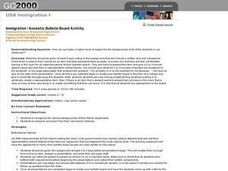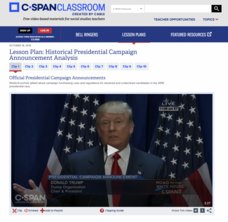Council for Economic Education
Paper Money of the Sung, Yuan, and Ming Dynasties
Why did the Chinese develop paper money? They were the first society to use paper currency. Learners consider why paper money was more convenient than other mechanisms of trade using a helpful lesson plan, which includes a graphic...
Curated OER
A Salute to Flag Day
Use Flag Day as a learning opportunity for your classroom. Collect a variety of books and other resources on the subject of the U.S. flag. Have pupils conduct independent research at home and come to class prepared to share some fun...
Curated OER
Immigration / Ancestry Bulletin Board Activity
Pupils bring items to school that represent their ancestry or heritage. Individually, they present this item to the class so that their classmates can discover their unique past. Using the Internet, they research their own family history...
Curated OER
Welcome to the First Day of School!
Classmates participate in a variety of getting-to-know-you activities for the first day of school. They make resolutions, become detectives about their fellow classmates, learn about each other by playing switch, and make...
University of Kansas
Newspaper in the Classroom
Newspapers aren't only for reading—they're for learning skills, too! A journalism unit provides three lessons each for primary, intermediate, and secondary grades. Lessons include objectives, materials, vocabulary, and procedure, and...
Dick Blick Art Materials
Simple Suminagashi
Go ahead. Spill the ink! Combine the study of art, social studies, and science with a Suminagashi (spilled ink) activity that produces "unique and unreproducible" works of art.
Institute of Electrical and Electronics Engineers
Working with Watermills
In collaborative groups, emerging engineers or environmental scientists plan and construct a water wheel or watermill that rotates for a total of three minutes. Everything you need to carry out this lesson is included: objectives,...
Roy Rosenzweig Center for History and New Media
Continental Differences
Students break into groups and closely investigate primary sources associated with the seven different continents. After deciding which continent their primary sources relate to, representatives from each group present their...
Curated OER
Soda to be Absent from Schools
Should schools serve soda to students? Learners read an artlcle that argues against the sale of soda in schools and engage in a class discussion. They then complete a short assessment to check for comprehension and reflect on the...
Roy Rosenzweig Center for History and New Media
Yankee Doodle: How Has It Changed over Time?
Grab your feathers and your hat! And perhaps some macaroni! It's time to investigate the evolution of "Yankee Doodle Dandy." Groups do a close reading of sheet music covers, lyrics, and even YouTube videos to see how this political song...
Roy Rosenzweig Center for History and New Media
European Explorers
To compare how the Spanish, French, and English approached the exploration of North America, class groups examine primary source documents and become experts on one of four explorers: Francisco Coronado, Robert LaSalle, Samuel de...
iCivics
The “Supreme” in Supreme Court
Does a public school have the right to restrict what t-shirts students wear? Discover what happened when this question was brought to the Supreme Court, and review other major cases in United States history involving judicial review....
PBS
Act of Duty
PBS provides educators with this "Utilization Guide," a four segment program that covers the Civil War, World War I, World War II, the Korean conflict, Vietnam, and the Gulf War. The 42-page packet includes lessons, background...
MENSA Education & Research Foundation
Media Literacy
Young learners today are bombarded by media manipulation. Help them develop the skills they will need to become savvy 21st century media consumers with a unit on media literacy.
National History Day
Helping Life and Aiding Death: Science, Technology, and Engineering at Work during World War I
Science, engineering, and United States history? Pupils research collections of artifacts from the Smithsonian to learn about historical scientific innovations. At the end of the lesson, they write an essay to discuss technology's...
Annenberg Foundation
Becoming Visible
The television and interstate highways both came of age in 1950s America. Scholars use film, text, and discussion to explore how these and other cultural icons shaped the literature of the time. Pupils also create a family history...
Smithsonian Institution
The Price of Freedom: Americans at War
An interactive resource covers all of the United States' most prominent and influential historic wars including the Vietnam War, the Cold War, the War of 1812, and the Korean War. Learners observe cause and effect as well as how violence...
C-SPAN
Historical Presidential Campaign Announcement Analysis
Using the announcements of presidential candidacies, pupils consider how contenders make their initial arguments to the public. A worksheet helps structure collaborative work to analyze 10 video clips. Writing prompts allow for extension...
Smithsonian Institution
POWs
Why did Vietnam POWs and their families receive more media attention than POWs in previous wars? To answer this question, class members view artifacts, read articles, and engage in class discussion. Individuals then assume the...
Humanities Texas
A President's Vision: Thomas Jefferson
Here you'll find a fantastic resource for analyzing several primary sources regarding Thomas Jefferson's presidency, from his election and home in Monticello to the Lewis and Clark expedition and the Louisiana Purchase.
Annenberg Foundation
Exploring Borderlands
What motivated Europeans to explore the New World, and what effects did their exploration have on Native American populations? The second installment of a 16-part American Passages series prompts pupils to watch a video and read several...
iCivics
Step Eight: Positions, Please!
Everyone sees the results of public policy, but not everyone understands the strategy that goes into creating an effective one. Now that your class understands the brainstorming process from earlier in the series, they continue on to the...
Curated OER
The Aesthetics of Activism
Students explore ways in which artistic expression has been used to promote awareness of AIDS. They create their own designs to promote awareness of a social, political, or economic issue of importance to their age group and community.
Curated OER
TE Activity: The Trouble with Topos
Students study the uses of topographical maps including the many forms that they take. They discover that the map features show its intended use such as city maps, wilderness maps, and state maps. They complete a worksheet in which they...























